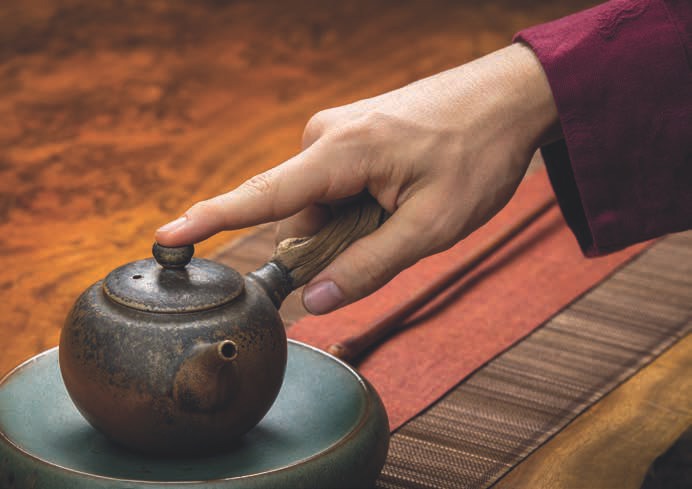
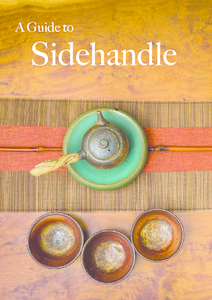 |
|

The sidehandle pot ceremony is the quintessence of our generation of the Hut. It is our contribution to future generations of Chajin. As we discussed earlier, this ceremony is an extension of leaves in a bowl, providing the opportunity to prepare more kinds of tea with the ceremonial, meditative ambience of leaves in a bowl. Long ago, all tea was processed simply, and therefore suitable to leaves in a bowl or boiling. But the last few centuries have seen a wonderful explosion in tea varietals, cultivars and processing methods. And not all of these teas are suitable for leaves in a bowl or boiling: some are compressed and would expand too much in the bowl, some are made of small leaves that would be difficult to drink without getting small buds and/or bits in your mouth, and others are too astringent or fresh, requiring flash steepings (quick decantation, in other words). The sidehandle ceremony is an addition to leaves in a bowl that allows us to prepare all the varieties of tea in a bowl with ceremonial force. With these two brewing methods alone, a Chajin can host ceremonies that suit all occasions.
It is important to remember, however, that the sidehandle is not meant to complicate leaves in a bowl. It is neither "higher" nor "better." One should not think of this ceremony as more advanced than leaves in a bowl. Sidehandle tea should be prepared with the same simple philosophy of focusing on meditative space, ceremonial celebration of Nature and tea drinking, and not on the quality of the tea - that's what gongfu tea is for. We chose the sidehandle as a vessel because it is the oldest and most rustic vessel, and is therefore conducive to the spirit of bowl tea: leaves, water and heat in its purest form. We prepare sidehandle tea without an evaluative mind. Each bowl is complete in and of itself. Consequently, we learn to set down the discriminating mind and rest in a harmony with this moment, this very bowl exactly as it is. We try to let go of "too hot" or "too bitter" and just be in the present moment fully, feeling the tea as it is. Sidehandles don't add anything at all to a bowl tea ceremony, other than the practical and down-to-earth ability to prepare more kinds of tea in this spirit.
Ceremonies teach us to remember to remember. All too often we forget what is most important to us: to spend time with our friends and loved ones, to connect on a deeper level, to discuss what's important and to honor this beautiful day. We must learn again to honor life and our bodies. Our respect-muscles have grown weak, so we must hone them to strength. Ceremonies turn attention into intention, creating energy that connects us to Nature, to our own hearts and to each other. In such a heart space, we remember that deep down, in the most spacious part of our hearts, we are all one Heart: one with all of Nature, with spirit and with each other, "tong yi xin (同一心)" in Chinese.

Don't forget the five basics of all tea brewing, which inform every kind of tea ceremony, including this sidehandle pot brewing. (You can review them in more detail in many past issues of Global Tea Hut - use the search bar on the "Past Issues" section of the website.)

All tea ceremonies start with the "stage" or "chaxi (茶席)." The truth is that the output of any system is determined by its input. Tea grown in a healthy environment without agrochemicals and with lots of biodiversity makes beautiful, healthy leaves. Similarly, the more you put into a tea ceremony, the more you get out of it. The more we prepare, the more we honor the occasion and our guests. This includes cleaning, decorating and also the practical elements of a session, like which teaware to choose, gathering spring water when possible, charcoal and heat, music if you wish to play some, incense and every other detail of the environment the tea will be prepared within.
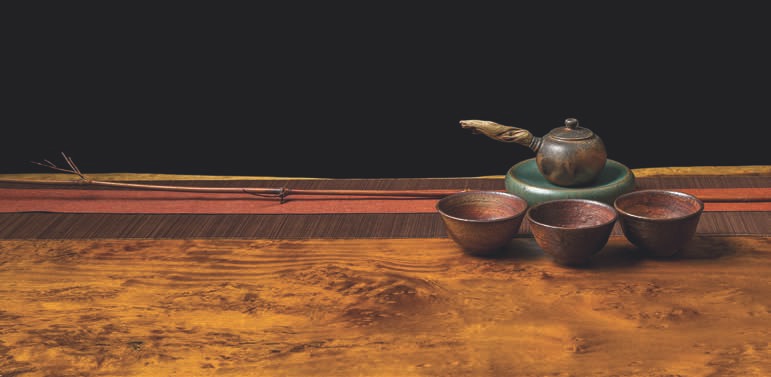
Chaxi practice always begins with cleaning. Cleaning is, in fact, eighty percent of Cha Dao! We clean inside our hearts to be pure channels of tea spirit, and we clean our tea space to celebrate the occasion and our guests. We all know how to host guests: we clean and decorate. And we all know what it feels like to enter a space that has been cleaned and decorated in our honor. This helps remind us of the spirit of tea, which is based on "one encounter, one chance (一期一會)." This means that if we gather here every day and prepare the same kind of tea with the same teaware, it will never, ever be this tea again. In fact, each bowl is a whole and complete moment in and of itself. And this moment will never be again. This is our now. This is our chance to be present and with tea. Making a chaxi for each ceremony teaches us to celebrate the occasion. It is precious to have a human body, to be relatively free of discomfort - not to mention to find the time in this busy world to pursue something so aimless as a bowl of tea!
Chaxi is focused mostly on honoring the occasion, one's guests and the tea of choice. There can be a theme that facilitates this, like a full moon or congratulations for one of your guests. Most often, on a day-to-day basis, we practice honoring the occasion by connecting Nature to our tea session. This is easy outdoors, since Nature surrounds us and is, therefore, our chaxi, but indoor sessions often strive to bring Nature inside, reminding us that this session is a part of a bigger world. This means autumn leaves in the fall, spring flowers in the spring, and so on. A chaxi is a mandala: a temporary work of art that connects a moment to Eternity. We create them to honor this precious time and space and to welcome our guests. We also prepare a chaxi to honor the tea we are preparing, and the hard work of the only true tea masters in the world: farmers.
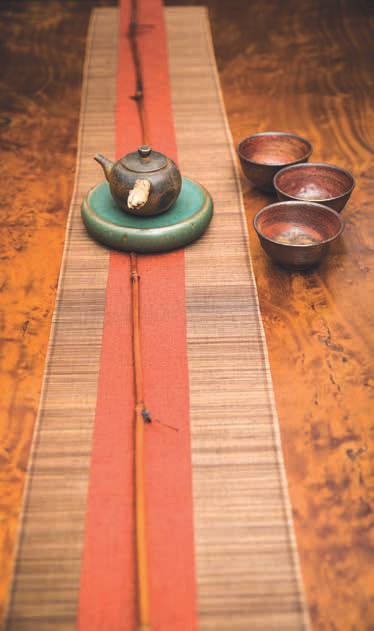
All ceremonies start with purification. If you wish, you may light some incense to purify the space, yourself and your guests. We like to keep the bowls to our side and bring them out after everyone is seated for sidehandle tea. This is different from bowl tea, in which the leaves and bowl are often out already as part of the chaxi. (You can make an exception for sidehandle and put the bowls out, or for leaves in a bowl, and have them to the side for certain occasions, but most sessions will follow this general pattern.)
Bring each bowl to your heart, and then place them one by one in front of your pot. Be as mindful as possible. Remember, a ceremony is to turn attention into intention. We should use every fiber of our being to prepare tea, filling our hearts with this moment, this time and place, this gathering and this tea. The most important element in any tea ceremony is the heart of the brewer - same tea and teaware, but change the brewer and the tea will be completely different, like giving a guitar and sheet music to different musicians, which results in a very different song. If your heart is still and very present, your tea will be steeped in this presence, and your guests will drink of it, guiding them to that same presence and stillness in their own hearts.
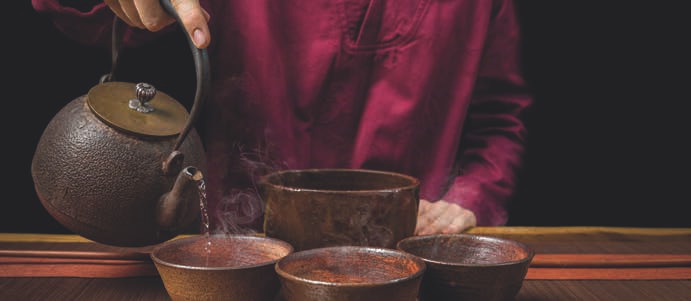
After all the bowls are set out, you can take a breath, lift the kettle and place some water in each bowl. Then, pour some hot water into the sidehandle pot itself to purify it. At this point, we gently bring out the wastewater container (jian shui, 建水). We keep this to our side or behind us to honor the space and our guests. As you go to wash the bowl, bring each bowl to the heart and then to the jian shui. This is done for a few reasons: First of all, bringing the bowls to and from the center means that you carry them around the sidehandle pot, preventing any chance of knocking the pot with your hand or arm. Second, bringing the bowls to the center makes it easy to switch hands so that you can rinse the bowls properly.
To rinse the bowls, you follow the same method as in a leaves in a bowl ceremony, which you can read about in the February 2017 issue. The off-hand is like the fork of a bicycle wheel. It is extended straight and does not move (this is important as your washing will be fumbling and awkward if you try to coordinate the movement of both hands). Extend the off-hand, with the fingers straight and unbent, to allow free, circular rotation of the bowl. Hold the bowl over the jian shui at a forty-five-degree angle and rotate it towards yourself with the strong hand (we also expel waste water towards ourselves to honor our guests). The aim of this circular movement is to rinse off/ purify the inside and outer rim of the bowl, where your guests' mouths will touch. You will have to practice the angle and speed of the rotation - if you move too fast, the water will spill out without rolling over the lip of the bowl and purifying the outer rim; and if you go too slow, the water will roll down the side of the bowl and burn your hand. You will know when you have rinsed the bowl all around completely, as you will feel a wetness on the inside of your thumb. At this point, put the palm of the off-hand into the curve of the bowl and use the strong hand to shake the bowl three times, removing any excess water.
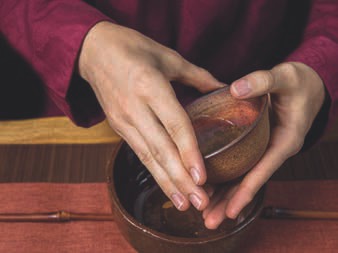
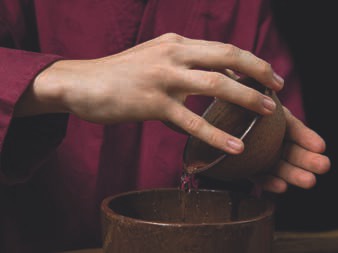
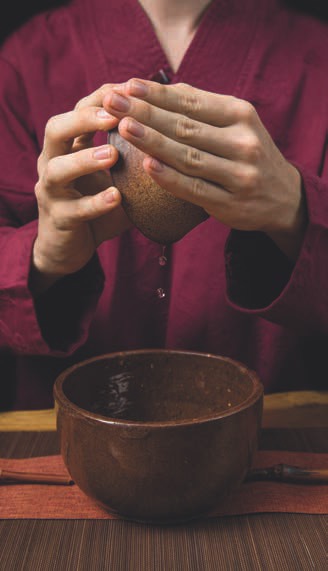
At this point, it is a good idea to reach down and wipe your hands off with a tea cloth (chabu, 茶布) before grabbing the handle of the pot. Then, decant the rinse water from the pot into the jian shui and set the pot back down gently.
Next, we add the tea to the pot using a scoop or "cha he (茶合)." Take a moment to place your hand over the tea and "whisper" your good intentions from your heart through your hand to the tea. Silently ask that this tea remind us of Nature, of the preciousness of this occasion and of our love for one another. Then place the tea gently in the pot. At this time, shower the leaves with some water, filling the pot only just above the leaves. This is to purify the Tea Herself. She also has journeyed by plane and truck to get to us, and we all know that a shower is good after a journey - washing off the dust of commoditization and other negativities She has passed through to reach us. This also wakes the tea up, readying her for the session. At this point, replace the jian shui to your side, as you won't need it anymore. Then, start to absorb the peace...

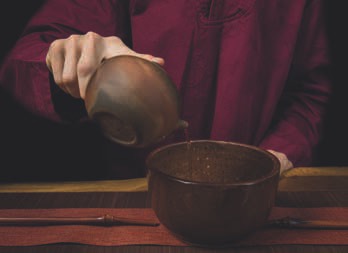
...Take a breath and calm yourself. Lift the lid and pour into the pot. Pour in circular motions at least until the water is above the leaves, so as to not scald any one leaf too much. When the pot is full, replace the lid and steep the tea. Take another breath before lifting the pot to decant the tea for your guests. Move in circular movements around the edges of the bowl. Bubbles make tea astringent and rough. We should pour smoothly in figure-eights around the row of bowls, back and forth until all the tea is decanted. Then, gently replace the pot. Sometimes, with some sidehandle pots, you may have to rotate the handle around to make sure it isn't in your way.
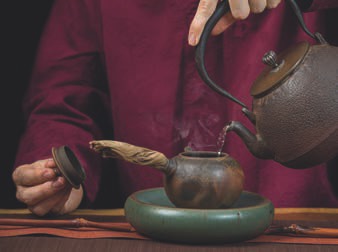
The first bowl is an important one. For this first bowl, we bring each bowl to our heart, cover it with one hand and make eye contact with the guest it is for, offering them a warm smile of welcome. Do this for each guest, one at a time as you hand them their bowls. For a lot of people, a silent tea ceremony can be intense and heavy. They resist the silence and connection with presence as it goes against the grain of their busy lives and active minds. They grow bored and feel that the situation is overbearing. By connecting to each guest at the beginning with a heartfelt smile, we have found that the silence of a tea session is magically alchemized into joyful silence. We aren't sure of all the mysteries of why this happens, but it certainly works. The rest of the session will flow much smoother and happier for you and your guests due to this one simple gesture of love!
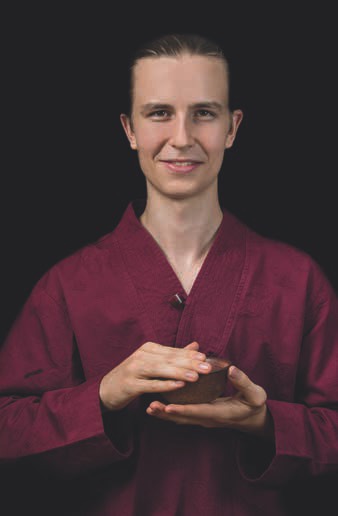
When you hand out each bowl, rotate the wrist outward - offering the part of the bowl your hand is not touching to each of your guests. We do this for every steeping. It is another of the many ways we honor our guests, opening the Universe that they can touch in each and every bowl!

After each bowl, return the bowls to the center. It helps to keep your bowl on the far side of your strong hand and place each consecutive bowl in order so you don't lose track of whose bowls are whose. The bowls then come and go, steeping after steeping. This is the breath of a tea ceremony, and the essence of its spirit: we are one (one gathering, one heart and one moment) and we are also apart (individuals with unique journeys).

Those of you who have attended our ceremonies before may have seen some of us putting our thumb on the spout, index finger on the button/pearl of the pot and our other three fingers flat against the side. This is not a ceremonial gesture and should not be done for this reason. We do this to listen to the tea to know when it is steeped to the proper degree. Learning to communicate with the tea leaves, water and liquor and feel the proper time to decant is a necessary skill in tea brewing. Practice listening in this way. Can you "hear" the frequency of the tea changing as the water becomes more and more infused with tea? Feel through your hand. All great art is performed with such sensitivity and feeling for the medium, and from painting to photography, artists will describe the intuitive sensations that went into their works. Tea is no different. Try to avoid using the mind, and instead, listen with the heart. This gesture can help you to become more sensitive to the changes in the liquor in the pot and decant at the proper time without the need for an external device like a timer. Like any art, the best tea is made not with the hand or mind, but with the soul. Therefore, feeling is always better than any kind of external data when serving tea ceremonially.

A proper ceremony must have a completion. Without it, your guests will still feel like they are in ceremonial space even after they leave, which will make it hard for them to go about their day and concentrate on whatever comes next. The oldest and simplest way to end a tea ceremony of any kind is with a bowl or cup of clear water, which represents a washing away of the ceremony - celebrating the precious impermanence of the occasion. At this point, we feel comfortable breaking silence and engaging in some conversation with our guests, usually about important matters or tea. (They often have questions.)
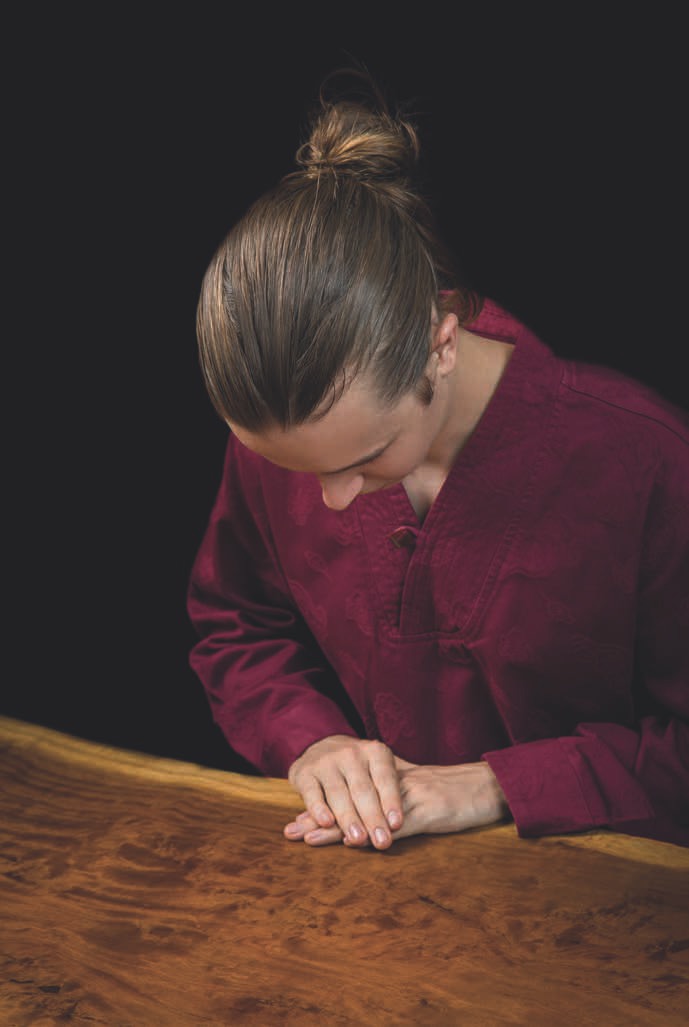
After your guests leave, take a few minutes to sit in the space. Tea ceremonies are very intimate, and getting up immediately does not honor the grace that has just happened. Cultivate gratitude for the occasion and love for the warmth of the space. We also like to think of each of our guests one by one, wishing them well on their journeys and hoping that the ceremony we just shared in brightens their day.
Finally, always leave time to clean up. Just as we clean before a session, failing to do so afterwards dishonors the occasion and our teaware - the instruments of our Dao and of our Tea-Joy. If you have somewhere to be, make sure you always leave adequate time to clean up your tea session, leaving no trace of what just happened. Cleaning is most of our practice of Cha Dao: cleaning outside and inside. We purify our hearts to be better servants of Tea, and of the Nature she speaks for; and we purify our space and our ceremonial instruments so that they reflect the purity we hope to inspire in our guests.
This is a part of learning to honor the occasion and rest in a graceful and loving relationship with impermanence. This is the moment at which the ceremony circles in on itself, returning to empty stillness.
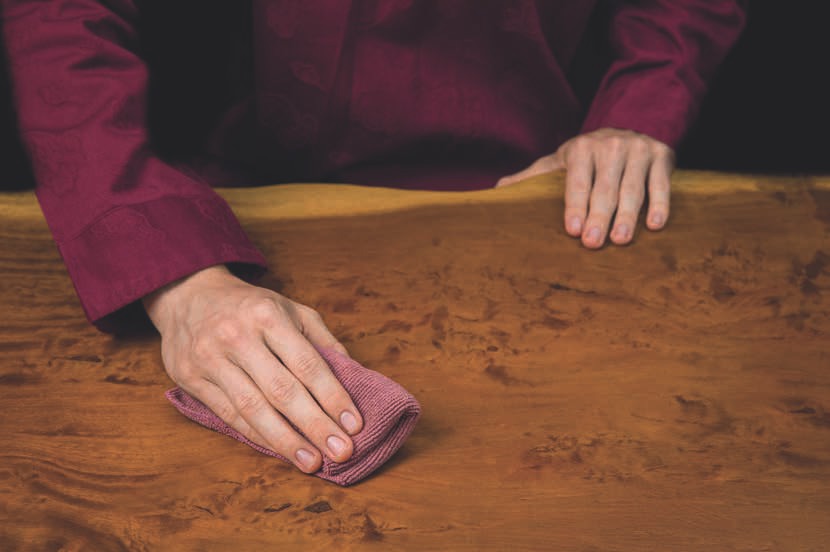
Over the centuries, there have been many designs of sidehandle pots, and a lot of ways to use them. Using teaware is always about harmonizing with its spirit - using it the way it is made to be used, and in a way that maximizes the connection our body, spirit and mind have to the brewing process. Which method facilitates grace and flow? Which method allows for a flow of Qi from the ground, through the heart to the hand? Which is limitless and free? When you hold the pot, does it feel like an extension of you? Are all the ways that you need to use the pot not only simple and easy to perform, but even encouraged? These are the questions to ask as you test out the different ways of making bowl tea with a sidehandle pot.
Nowadays, you really only see people using sidehandle pots in one of two ways, and most sidehandles are created to facilitate one of these. One is traditional and the other is more modern, and, we feel, far more constricting in brewing. The modern method is to wrap the fist around the handle and put the thumb on the pearl/button, pouring inwards towards yourself. Pots designed for this kind of control will usually have a shorter handle and the distance between the handle and spout will be much smaller. If the handle is wood, you may even notice that the potter has angled/attached the wood in a way that forces you to hold the pot in this way due to bumps, ridges, twists or knots. This modern method is unfounded, and has no historical precedent. Every antique sidehandle we have seen is based on using the index finger, which we will discuss in a bit.
There are several issues with pouring from a sidehandle with your fist down and thumb on the button: First, you are always pouring towards yourself, facing the bottom of the pot towards your guests. In tea, we always incorporate every possible opportunity to pay respect to our guests, so that "guest and host may be one." All our heart is poured into our service. A more serious issue, however, is that you have much less control over the speed and distance of pour, and your circular movements are greatly restricted, especially as the pot travels back and further down a row of bowls. (The backpour is more restricted as you cannot circle out.) We try to pour on the sides of the bowl, as bubbles make a tea rough. This becomes hard to do pouring in this way, as the wrist pinches in outward angles. And you also have far less control over the speed of the decantation, as this method really swivels on an "on/off" pivot.
The traditional way to hold a sidehandle is to use the bottom three fingers to wrap around the handle, the thumb for support underneath and the index finger on the button/pearl. The index finger is a natural extension of the hand/wrist/arm, which is why people everywhere use it to point. We have more Qi in our index finger than any other, which means more control over it. It is the most powerful of our fingers. We once asked a friend of ours who makes handcrafted rings which was the most powerful finger to wear a ring on, and he responded that "the index finger is the strongest" without a pause to reflect. If you extend your arm straight out in front of you, with your wrist slightly bent up, and then extend your index finger, you will feel the control and power you have down from the elbow, through the arm and wrist to the hand and finger. Pots made for this traditional style of brewing will have more space between the spout and handle, and usually have straighter handles. An angled handle works better with our ceremony.
Holding the pot in the traditional way creates more balance, grace and fluidity. In both forward and backward movements down a row of bowls, you can rotate the pot inwards or outwards around the rims of the bowls, as you need. This method allows a far greater circular control and much more choice over the speed and distance of the pour as well. This is important, as different kinds of tea are ideally decanted at different speeds. With this method, you can control how far you pour and whether the pour is a trickle or a gushing torrent - and everything between.
Don't take our word for it. Try holding your sidehandle pot in both of these ways. Have a loved one put their thumb on the button and pour towards themselves while you sit across from them and watch from the perspective of a guest. Then, switch to the traditional method. Which was more graceful? Didn't you enjoy seeing the pour? Next, try the two methods yourself. Notice which one is more limber, free and is conducive to all the muscles, joints and natural movements of your arm, wrist, hand and fingers. Which feels more natural? Then try pouring some water. Notice the control, fluency and grace as you go back and forth down a row of bowls. Stop and try changing distance and speed into one of the bowls. Which method facilitates this? Do you have more control with one of these two methods? Does the water flow more smoothly? Then brew some tea and see how each session feels, physically and energetically. Which did the tea prefer?

